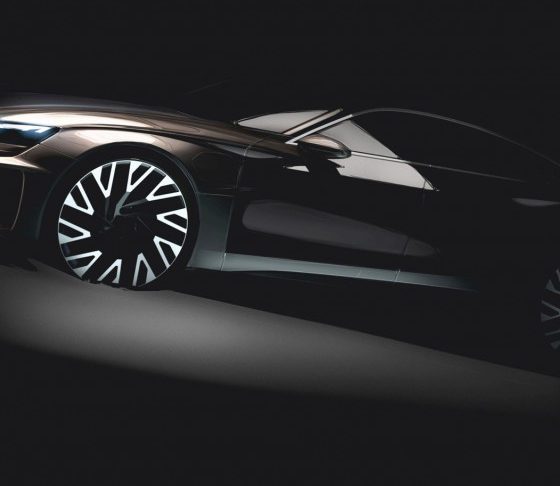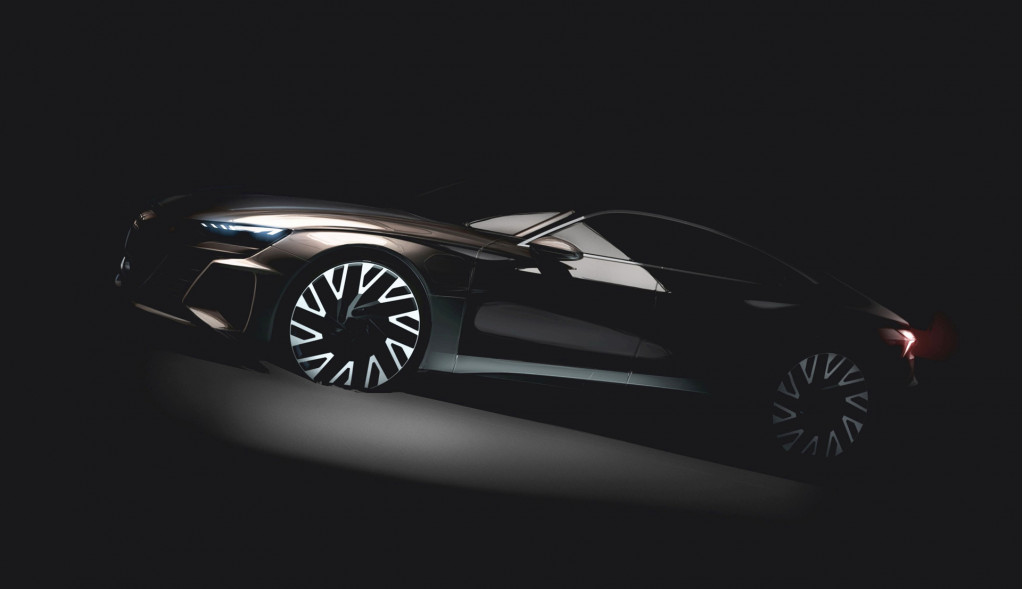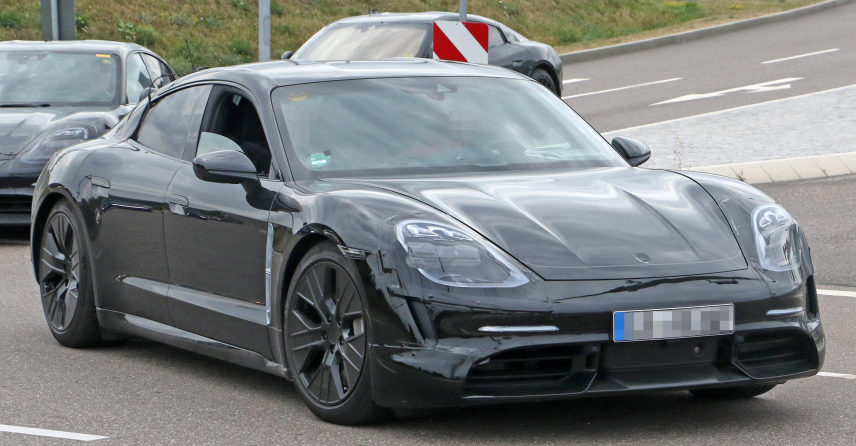

News
Porsche Taycan to serve as platform for Audi’s upcoming Sport E-tron GT Concept
While Porsche is yet to reveal the production version of the Taycan, the vehicle is already set to become the platform of another upcoming EV — the Audi Sport E-tron GT Concept, which is set to make a debut this coming November at the 2018 Los Angeles Auto Show.
The Audi Sport E-tron GT Concept was initially announced last March during the company’s annual conference in Ingolstadt, Germany. During its announcement, Rupert Stadler, Audi’s currently-suspended CEO, stated that the Sport E-Tron GT would offer an experience to drivers that is both familiar and unique. A teaser for the vehicle was released then as well, and it depicted an outline of a car that was aggressive and sleek.
“It’s a car that thrills at first glance, a fully-electric Gran Turismo that stands for a new kind of sportiness,” Stadler said.

While much of the details about Audi’s upcoming all-electric sports car remain unannounced, a company spokesperson has provided The Drive with some interesting new information about the vehicle. For one, the spokesperson noted that the Audi Sport E-tron GT is being developed in partnership with Porsche. This suggests that the Sport E-tron GT would likely share the J1 design, the same platform used in the Taycan, Porsche’s first all-electric car that is expected to compete with the Tesla Model S.
The Taycan is equipped with two permanently excited synchronous motors (PSM) that are expected to offer outputs reaching 600 hp, as well as an 800-volt battery that can charge up to 80% in just ~15 minutes using a 350 kW charging system like the upcoming IONITY Network. Thanks to its electric motors, the Taycan is also quite zippy, with a listed 0-60 mph time of 3.5 seconds and a top speed of 155 mph. Considering that Audi’s electric grand tourer will be utilizing the Taycan’s platform, there is a pretty good chance that the vehicle would feature comparable performance specs as its Porsche cousin.

Utilizing the Taycan’s platform could ultimately benefit Audi in the long run, especially considering that Porsche’s first all-electric car is shaping up to be a well-rounded, well-thought-out vehicle. Porsche, after all, appears to be one of the legacy automakers that is taking the electrification of its fleet seriously, as exhibited by the company’s initiative in ensuring that the Taycan is supported by a fast-charging network similar to Tesla’s Superchargers once it begins rolling out to customers. By using the Taycan’s platform, Audi would simply need to build onto Porsche’s design, allowing the carmaker to optimize the finer aspects of the Sport E-tron GT.
Just like Porsche, Audi hopes to roll out a fleet of electric car offerings in the coming years, starting with the e-tron SUV, which was unveiled earlier this week. By 2025, Audi plans to have more than 20 electrified vehicles, with more than 50% being fully-electric. Porsche, for its part, is expected to release the Taycan sometime next year, starting with an initial production run of 20,000 vehicles per year.

News
Tesla starts showing how FSD will change lives in Europe
Local officials tested the system on narrow country roads and were impressed by FSD’s smooth, human-like driving, with some calling the service a game-changer for everyday life in areas that are far from urban centers.

Tesla has launched Europe’s first public shuttle service using Full Self-Driving (Supervised) in the rural Eifelkreis Bitburg-Prüm region of Germany, demonstrating how the technology can restore independence and mobility for people who struggle with limited transport options.
Local officials tested the system on narrow country roads and were impressed by FSD’s smooth, human-like driving, with some calling the service a game-changer for everyday life in areas that are far from urban centers.
Officials see real impact on rural residents
Arzfeld Mayor Johannes Kuhl and District Administrator Andreas Kruppert personally tested the Tesla shuttle service. This allowed them to see just how well FSD navigated winding lanes and rural roads confidently. Kruppert said, “Autonomous driving sounds like science fiction to many, but we simply see here that it works totally well in rural regions too.” Kuhl, for his part, also noted that FSD “feels like a very experienced driver.”
The pilot complements the area’s “Citizen Bus” program, which provides on-demand rides for elderly residents who can no longer drive themselves. Tesla Europe shared a video of a demonstration of the service, highlighting how FSD gives people their freedom back, even in places where public transport is not as prevalent.
What the Ministry for Economic Affairs and Transport says
Rhineland-Palatinate’s Minister Daniela Schmitt supported the project, praising the collaboration that made this “first of its kind in Europe” possible. As per the ministry, the rural rollout for the service shows FSD’s potential beyond major cities, and it delivers tangible benefits like grocery runs, doctor visits, and social connections for isolated residents.
“Reliable and flexible mobility is especially vital in rural areas. With the launch of a shuttle service using self-driving vehicles (FSD supervised) by Tesla in the Eifelkreis Bitburg-Prüm, an innovative pilot project is now getting underway that complements local community bus services. It is the first project of its kind in Europe.
“The result is a real gain for rural mobility: greater accessibility, more flexibility and tangible benefits for everyday life. A strong signal for innovation, cooperation and future-oriented mobility beyond urban centers,” the ministry wrote in a LinkedIn post.
News
Tesla China quietly posts Robotaxi-related job listing
Tesla China is currently seeking a Low Voltage Electrical Engineer to work on circuit board design for the company’s autonomous vehicles.

Tesla has posted a new job listing in Shanghai explicitly tied to its Robotaxi program, fueling speculation that the company is preparing to launch its dedicated autonomous ride-hailing service in China.
As noted in the listing, Tesla China is currently seeking a Low Voltage Electrical Engineer to work on circuit board design for the company’s autonomous vehicles.
Robotaxi-specific role
The listing, which was shared on social media platform X by industry watcher @tslaming, suggested that Tesla China is looking to fill the role urgently. The job listing itself specifically mentions that the person hired for the role will be working on the Low Voltage Hardware team, which would design the circuit boards that would serve as the nervous system of the Robotaxi.
Key tasks for the role, as indicated in the job listing, include collaboration with PCB layout, firmware, mechanical, program management, and validation teams, among other responsibilities. The role is based in Shanghai.
China Robotaxi launch
China represents a massive potential market for robotaxis, with its dense urban centers and supportive policies in select cities. Tesla has limited permission to roll out FSD in the country, though despite this, its vehicles have been hailed as among the best in the market when it comes to autonomous features. So far, at least, it appears that China supports Tesla’s FSD and Robotaxi rollout.
This was hinted at in November, when Tesla brought the Cybercab to the 8th China International Import Expo (CIIE) in Shanghai, marking the first time that the autonomous two-seater was brought to the Asia-Pacific region. The vehicle, despite not having a release date in China, received a significant amount of interest among the event’s attendees.
Elon Musk
Elon Musk and Tesla AI Director share insights after empty driver seat Robotaxi rides
The executives’ unoccupied tests hint at the rapid progress of Tesla’s unsupervised Robotaxi efforts.

Tesla CEO Elon Musk and AI Director Ashok Elluswamy celebrated Christmas Eve by sharing personal experiences with Robotaxi vehicles that had no safety monitor or occupant in the driver’s seat. Musk described the system’s “perfect driving” around Austin, while Elluswamy posted video from the back seat, calling it “an amazing experience.”
The executives’ unoccupied tests hint at the rapid progress of Tesla’s unsupervised Robotaxi efforts.
Elon and Ashok’s firsthand Robotaxi insights
Prior to Musk and the Tesla AI Director’s posts, sightings of unmanned Teslas navigating public roads were widely shared on social media. One such vehicle was spotted in Austin, Texas, which Elon Musk acknowleged by stating that “Testing is underway with no occupants in the car.”
Based on his Christmas Eve post, Musk seemed to have tested an unmanned Tesla himself. “A Tesla with no safety monitor in the car and me sitting in the passenger seat took me all around Austin on Sunday with perfect driving,” Musk wrote in his post.
Elluswamy responded with a 2-minute video showing himself in the rear of an unmanned Tesla. The video featured the vehicle’s empty front seats, as well as its smooth handling through real-world traffic. He captioned his video with the words, “It’s an amazing experience!”
Towards Unsupervised operations
During an xAI Hackathon earlier this month, Elon Musk mentioned that Tesla owed be removing Safety Monitors from its Robotaxis in Austin in just three weeks. “Unsupervised is pretty much solved at this point. So there will be Tesla Robotaxis operating in Austin with no one in them. Not even anyone in the passenger seat in about three weeks,” he said. Musk echoed similar estimates at the 2025 Annual Shareholder Meeting and the Q3 2025 earnings call.
Considering the insights that were posted Musk and Elluswamy, it does appear that Tesla is working hard towards operating its Robotaxis with no safety monitors. This is quite impressive considering that the service was launched just earlier this year.








